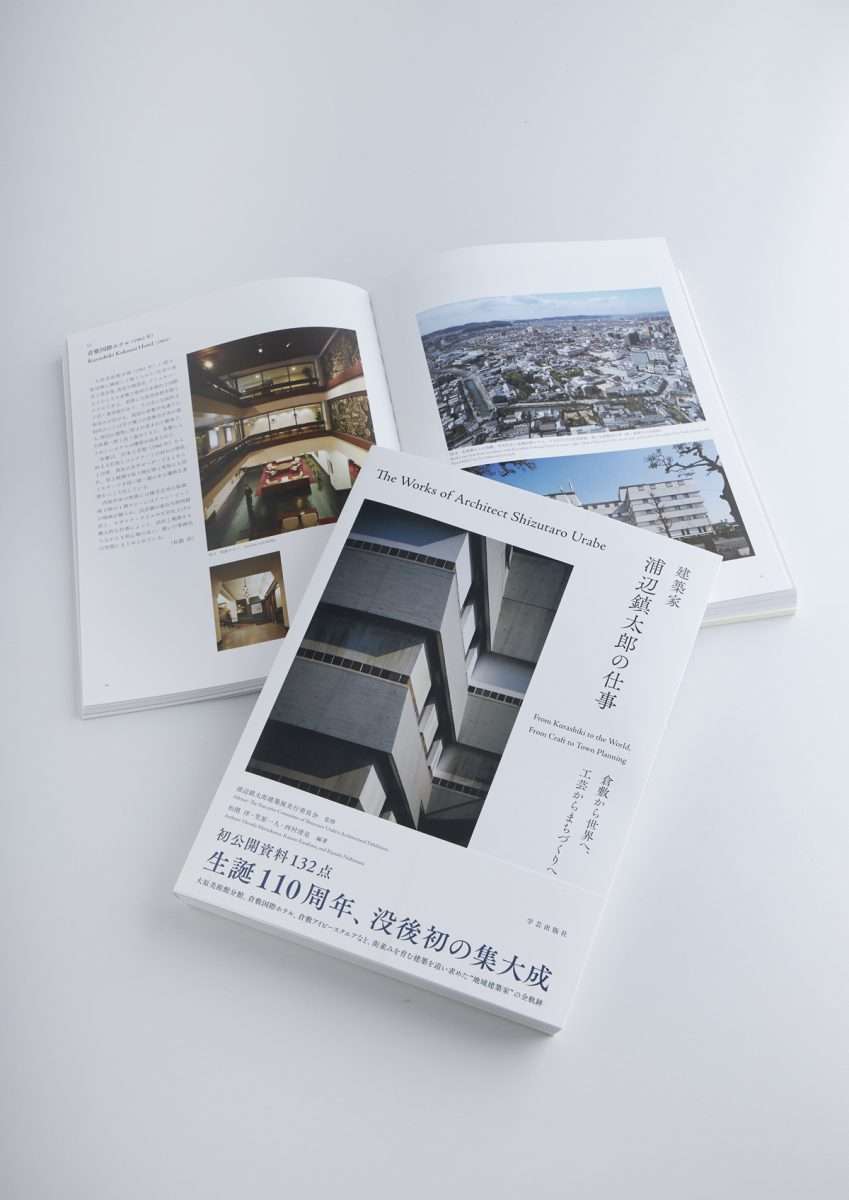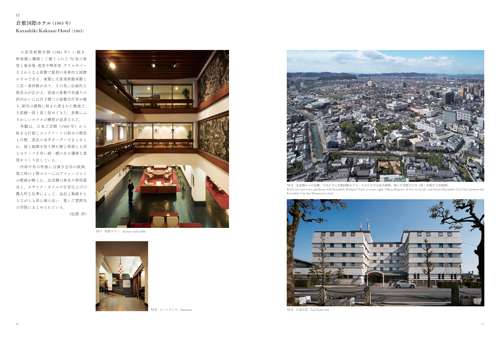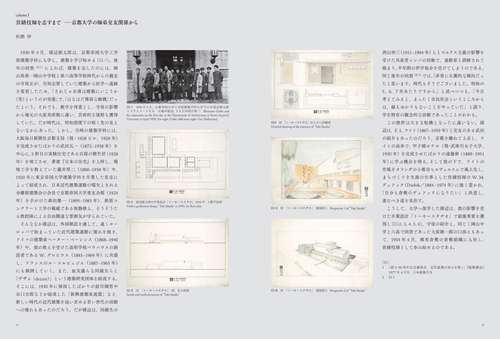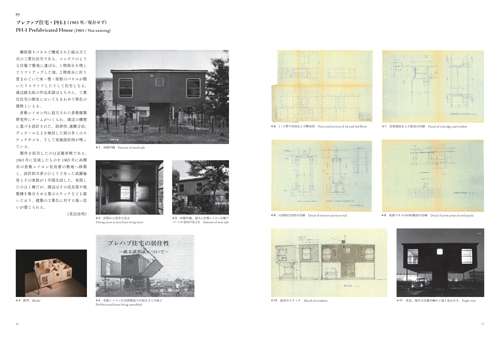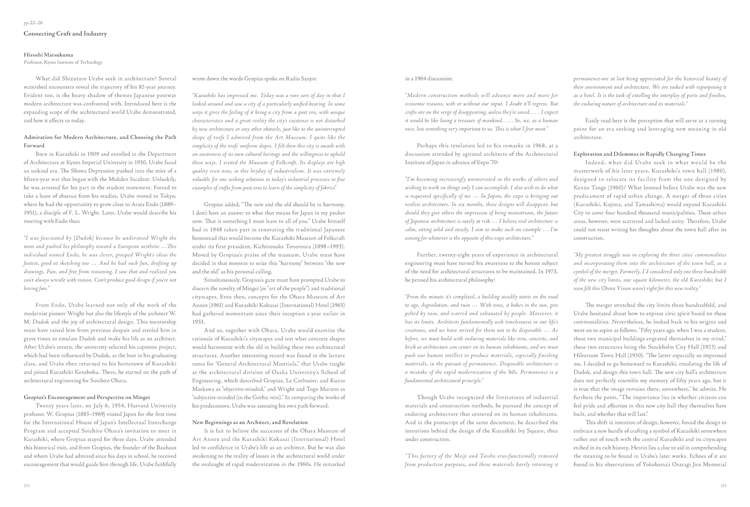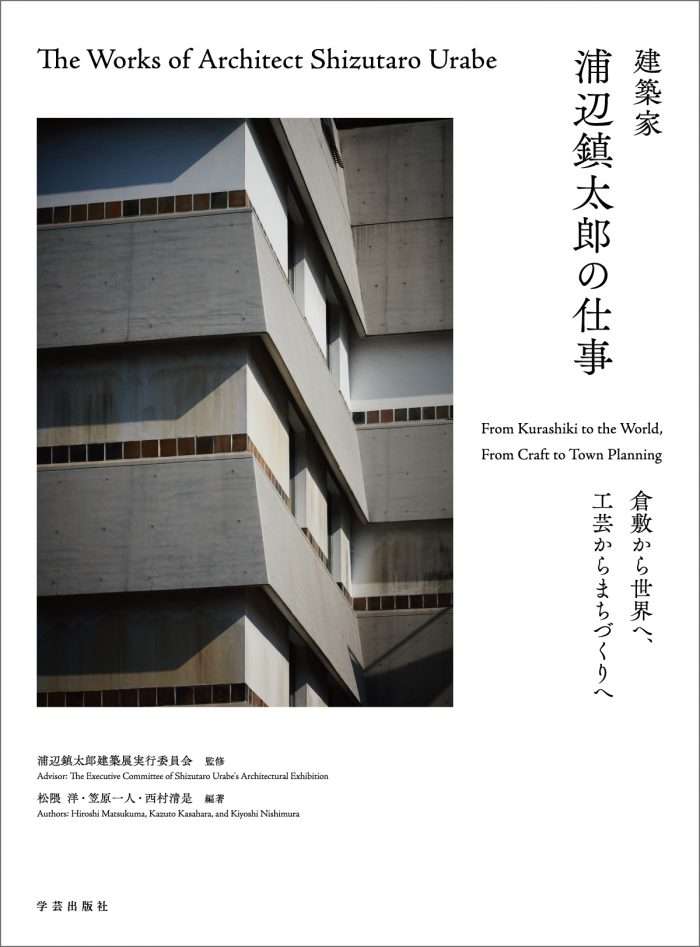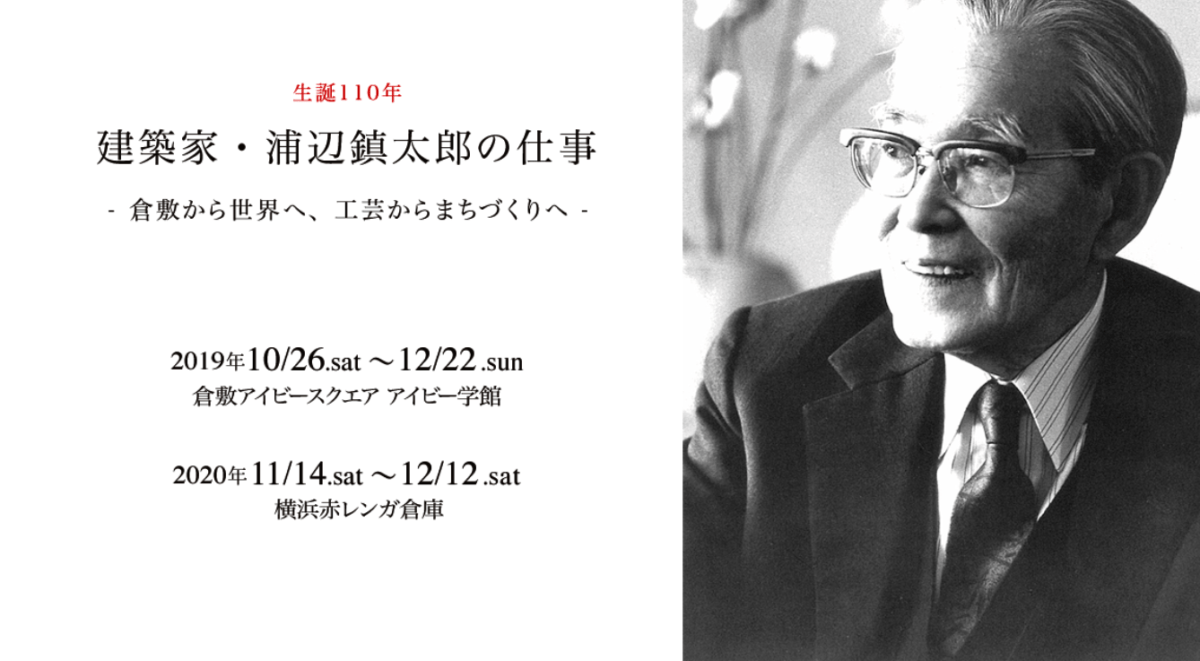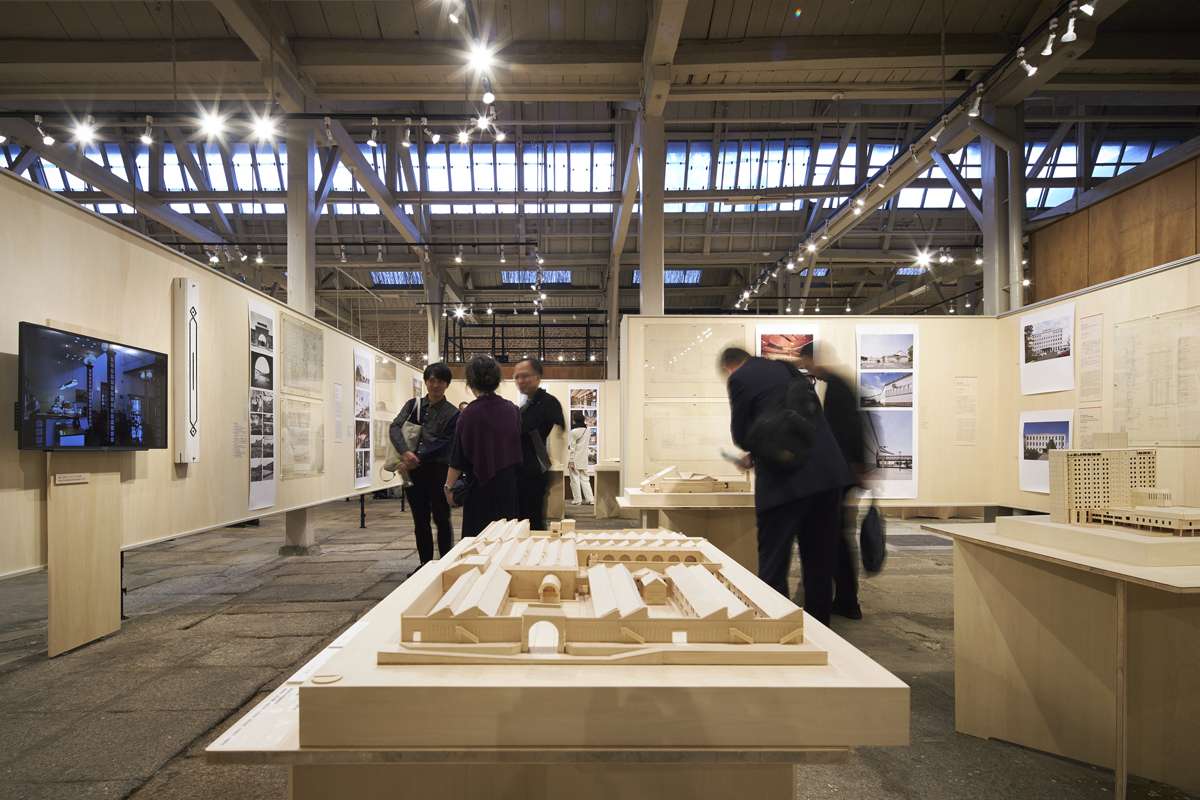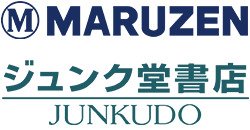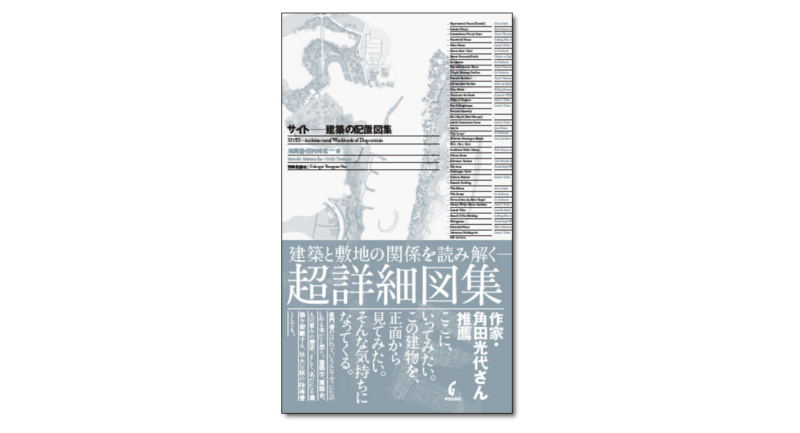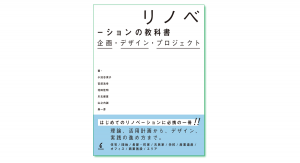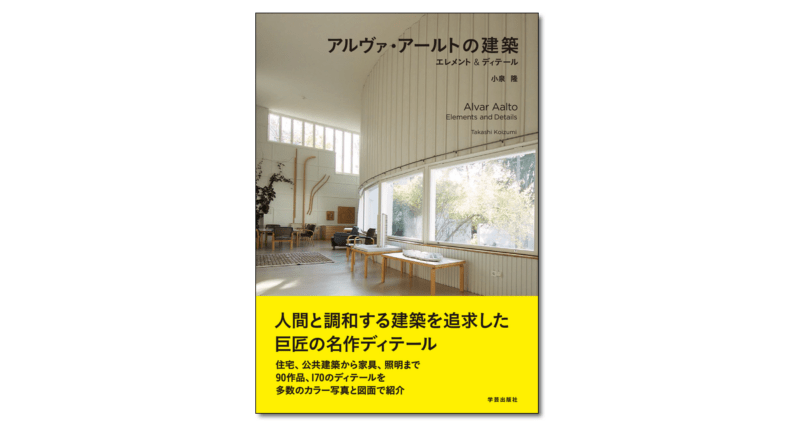建築家 浦辺鎮太郎の仕事
『建築家 浦辺鎮太郎の仕事 倉敷から世界へ、工芸からまちづくりへ』
浦辺鎮太郎建築展実行委員会 監修/松隈 洋・笠原一人・西村清是 編著
内容紹介
大原美術館分館や倉敷国際ホテルなど、実業家・大原總一郎と共に倉敷の伝統・風土と対話し、地域主義を実践した初期。そして晩年、横浜での仕事に代表されるポスト・モダン時代の自在な造形まで。約300点に及ぶ実作から主要37作品を厳選し、初公開図面やスケッチ132点も収録。身の丈にあう建築を求め続けた建築家の全軌跡。英訳も全文収録。
B5変判・320頁・本体3600円+税
ISBN 978-4-7615-3252-9
発行 2019/10/20
装丁 木村幸央
- 12 倉敷国際ホテル(1963 年)
- 営繕技師を志すまで―京都大学の師弟交友関係から
- 04 プレファブ住宅・PH-1(1963 年/現存せず)
- 25 倉敷アイビースクエア(1974 年)1
- 25 倉敷アイビースクエア(1974 年) 2
- 掲載作品地図
- Einglish Text
- 目次1
- 目次2

ごあいさつ
浦辺鎮太郎と倉敷と大原總一郎/大原謙一郎
知られざる浦辺鎮太郎の建築/藤森照信
市民のための建築を求めて/松葉一清
クラフトとインダストリーをつないで/松隈 洋
■ 序章 営繕技師としての出発 1934―1950 年
column I 営繕技師を志すまで―京都大学の師弟交友関係から/松隈 洋
column II デュドックへの思い/笠原一人
column III 薬師寺主計との出会い/上田恭嗣
column IV 1953 年ノート/西村清是
■ 第 1 章 倉敷に根ざした地域主義の実践 1951.1963 年
二代続けた倉敷のまちづくり/上田恭嗣
浦辺鎮太郎と工業化/花田佳明
異なるモノをつなぐ対話的感性/竹原義二
01 日本基督教団西条栄光教会(礼拝堂・牧師館・西条栄光幼稚園)(1951 年)
column 01 西条栄光教会の調査から見えてくるもの/和田耕一
02 倉敷考古館増築(1957 年)
column 02 倉敷考古館にみる「調和と区別」のデザイン/笠原一人
03 旅館くらしき(改修/ 1957 年)・珈琲館(1971 年)
topic 01 倉敷美観地区のまちなみ/辻野純徳
04 プレファブ住宅・PH-1(1963 年/現存せず)
column 04 プレファブ住宅・PH-1 の詳細について/花田佳明
05 倉敷レイヨン岡山第2 工場(1960 年)
column 05 工場建築から読み解く浦辺流/西村清是
06 倉敷レイヨン高槻アパート(RC-60 型)・独身寮(1964 年/現存せず)
column 06 RC-60 型―浦辺鎮太郎の社員寮建築/柳沢 究
07 日本工芸館(1960 年/現存せず)
column 07-1 クラシキモデュール(KM)について/西村清是
column 07-2 民芸運動と壁庇/笠原一人
08 石井記念愛染園女子単身者住宅(1961年/現存せず)・保育所(1962年/現存せず)
09 石井記念愛染園愛染橋病院(1965 年/現存せず)
column 08・09 一連の愛染園の施設/笠原一人
10 京都航空ビル(1961 年/現存せず)
11 大原美術館分館(1961 年)
column 11 大原美術館分館の八つの計画をめぐって/松隈 洋
12 倉敷国際ホテル(1963 年)
column 12 倉敷国際ホテルに結実する大原と浦辺のホテル構想/松隈 洋
13 倉敷ユースホステル(1965 年)
14 浜幸ビル(1966 年 )
15 両備バス西大寺ターミナル(1966 年)
■ 第 2 章 倉敷モデルの展開から転換へ 1964.1974 年
モダニズムと「日本」─浦辺鎮太郎建築の葛藤と位置/重村 力
倉敷のまちが浦辺から受け継ぐもの/楢村 徹
残された浦辺精神の現在/西村清是
16 東京造形大学(第Ⅰ期:1966 年/現存せず)
17 西条市立郷土博物館東予民芸館(現・愛媛民芸館)(1967 年)
18 東京女子大学研究本館1・2 号館(2 号館:1967 年、1 号館:1968 年)
19 倉敷レイヨン中央研究所(現・クラレくらしき研究センター)(1968 年)
column 19 大原總一郎への思い/西村清是
20 倉敷文化センター(現・倉敷公民館)(1969 年)
21 西鉄グランドホテル(1969 年)
column 21 浦辺鎮太郎のホテル建築/西村清是
22 倉敷商工会館(1971 年)
23 倉敷市水道局庁舎(現・倉敷市立自然史博物館)(1971 年)
24 倉敷市民会館(1972 年)
column 24 大原總一郎の夢/西村清是
25 倉敷アイビースクエア(1974 年)
column 25-1 コンバージョンの手法から読み解く/福濱嘉宏
column 25-2 「黒と白」から「白と赤」への作風の転機/西村清是
topic 02 一丁シャンゼリゼ計画と大原構想/西村清是
■ 第 3 章 ポスト・モダン時代の自在な造形 1970.1984 年
浦辺さんとポスト・モダニズム/松葉一清
庁舎建築から見る浦辺鎮太郎/笠原一人
都市デザインの横浜と浦辺の関わり/曽我部昌史
26 千里阪急ホテル(第Ⅰ期:1970 年、第Ⅱ期:1976 年)
27 紀伊風土記の丘松下記念資料館(1971 年)
column 27 遺跡へのリスペクトとその現代的「再演」/平田隆行
28 黒住教新霊地神道山大教殿(1974 年)
column 28 近代における宗教建築としての黒住教・太陽の神殿/朽木順綱
29 倉敷市庁舎(1980 年)
column 29 倉敷市庁舎への思い/笠原一人
topic 03 幻の市庁舎計画案/笠原一人
30 倉敷中央病院(第Ⅰ期:1975 年、第Ⅱ期:1980 年、第Ⅲ期:1981 年)
column 30 創立の志を受け継ぐ病院/辻野純徳
31 倉敷駅前再開発東ビル・西ビル(1980 年)
32 三州足助屋敷(1980 年)
33 六高記念館(1980 年)
34 日本女子大学成瀬記念館(1984 年)
35 大佛次郎記念館(1978 年)
column 35 撮影を通して見る浦辺建築/奥村浩司
36 横浜開港資料館(1981 年)
column 36 浦辺鎮太郎の建築類型学/中井邦夫
37 神奈川近代文学館(1984 年)・霧笛橋(1986 年)
- 浦辺鎮太郎の言葉/編・松隈 洋
- 掲載作品地図
- 年表
- 文献目録
- 作品リスト
- 出典
- English Texts
English Texts
Foreword
Shizutaro Urabe, Kurashiki, and Soichiro Ohara / Ken-ichiro Oohara
The Unknown Architecture of Shizutaro Urabe / Terunobu Fujimori
In Pursuit of Architecture for Citizens / Kazukiyo Matsuba
Connecting Craft and Industry / Hiroshi Matsukuma
■Introduction The Starting as a Facilities Engineer and the Encounter with Folk Art, 1934 – 1950
column I Before Deciding to Be a Facilities Engineer .Based on the Relationships with Teachers and Friends at Kyoto University /Hiroshi Matsukuma
column II Admiration for Dudok / Kazuto Kasahara
column III Meeting with Kazue Yakushiji / Yasutsugu Ueda
column IV The 1953 Notes / Kiyoshi Nishimura
■Chapter 1 Practice of Regionalism Rooted in Kurashiki, 1951 – 1963
Town Development of Kurashiki that Continued for Two Generations / Yasutsugu Ueda
Shizutaro Urabe and Industrialization / Yoshiaki Hanada
Dialogic Sensibility to Connect Different things / Yoshiji Takehara
project 01 The United Church of Christian in Japan Saijo Eiko Kyokai (Saijo Glory Church)(a chapel, a rectory, and Saijo Eiko kindergarten) (1951)
column 01 The Things That Can Be Seen from an Investigation of the Saijo Eiko Kyokai (Saijo Glory Church) / Koichi Wada
project 02 The Kurashiki Archaeological Museum Extension (1957)
column 02 Design of “Harmony and Distinction” in the Kurashiki Archaeological Museum / Kazuto Kasahara
project 03 Ryokan Kurashiki (Renovation / 1957) & Coffee Kan (1971)
topic 01 The Townscape of the Kurashiki Bikan Historical Quarter / Yoshinori Tsujino
project 04 PH-1 Prefabricated House (1963 / Not existing)
column 04 About the Details of the PH-1 Prefabricated House / Yoshiaki Hanada
project 05 Kurashiki Rayon Co., Ltd., Second Okayama Plant (1960)
column 05 The Urabe’s Way Deciphered from His Factory Architecture / Kiyoshi Nishimura
project 06 Kurashiki Rayon Takatsuki Apartment (Type RC-60) & Singles. Dormitory (1964 /Not existing)
column 06 Type RC-60: Shizutaro Urabe’s Employee Housing Architecture / Kiwamu Yanagisawa
project 07 Japan Folk Art Museum (1960 / Not existing)
column 07-1 On the Kurashiki Module (KM) / Kiyoshi Nishimura
column 07-2 The Mingei (Folk Crafts) Movement and Pent Roof Walls / Kazuto Kasahara
project 08 The Ishii Memorial Aizen-en Single Female Housing (1961 / Not existing)and Nursery School (1962 / Not existing)
project 09 Ishii Memorial Aizen-en Aizenbashi Hospital (1965 / Not existing)
column 08・09 The Series of Facilities for Aizen-en / Kazuto Kasahara
project 10 The Kyoto Airlines Building (1961 / Not existing)
project 11 The Annex for the Ohara Museum of Art (1961)
column 11 Eight Plans for the Ohara Museum of Art, Annex / Hiroshi Matsukuma
project 12 Kurashiki Kokusai Hotel (1963)
column 12 Ohara and Urabe’s Hotel Concept that Comes to Fruition in the Kurashiki Kokusai Hotel / Hiroshi Matsukuma
project 13 The Kurashiki Youth Hostel (1965)
project 14 The Hamako Building (1966)
project 15 The Ryobi Saidaiji Bus Terminal (1966)
■Chapter 2 From the Development of the Kurashiki Model to Its Transformation, 1964 – 1974
Modernism and “Japan” .Struggle and Position of Shizutaro Urabe’s Architecture / Tsutomu Shigemura
What the Town of Kurashiki Inherits from Urabe / Toru Naramura
The Urabe Spirit that Remains Today / Kiyoshi Nishimura
project 16 Tokyo Zokei University (Phase I: 1966 / Not existing)
project 17 The Toyo Folk Art Museum of the Saijo City Folk Museum(the present-day Ehime Museum of Folkcraft) (1967)
project 18 Tokyo Woman’s Christian University, Building No.1 (1968) & No.2 (1967)
project 19 The Kurashiki Rayon Central Research Center(the present-day Kuraray Kurashiki Research Center) (1968)
column 19 Thoughts Toward Soichiro Ohara / Kiyoshi Nishimura…… 289
project 20 The Kurashiki Cultural Center (the present-day Kurashiki Public Hall) (1969)
project 21 The Nishitetsu Grand Hotel (1969)
column 21 Shizutaro Urabe‘s Hotel Architecture / Kiyoshi Nishimura
project 22 The Kurashiki Chamber of Commerce and Industry Hall (1971)
project 23 The Kurashiki City Bureau of Waterworks Building(the present-day Kurashiki Museum of Natural History) (1971)
project 24 The Kurashiki City Auditorium (1972)
column 24 Soichiro Ohara’s Dream / Kiyoshi Nishimura
project 25 Kurashiki Ivy Square (1974)
column 25-1 Deciphering from the Conversion Method / Yoshihiro Hukuhama
column 25-2 The Turning Point in Style from “Black and White” to “White and Red” / Kiyoshi Nishimura
topic 02 The Petits Champs Elysees and the Ohara Vision / Kiyoshi Nishimura
■Chapter 3 Masterful Form-Creation in the Era of Post-Modernism, 1970 – 1984
Mr. Urabe and Post-Modernism / Kazukiyo Matsuba
Shizutaro Urabe Seen from the Perspective of Municipal Hall Architecture / Kazuto Kasahara
How was Shizutaro Urabe Involved in Urban Design City Yokohama / Masashi Sogabe
project 26 The Senri Hankyu Hotel (Phase I: 1970 , Phase II: 1976)
project 27 The Kii-fudoki-no-oka Museum of Archaeology and Folklore Matsushita Memorial Archives (1971)
column 27 Respect for Historical Ruins and Their Modern “Recreation” / Takayuki Hirata
project 28 The Kurozumi-Kyo New Daikyoden Prayer Hall in Shintozan (1974)
column 28 The Kurozumi-Kyo’s Shrine of the Sun as Religious Place of Modern Architecture / Yoshitsuna Kutsuki
project 29 The Kurashiki City Hall (1980)
column 29 Desire for the Kurashiki City Hall / Kazuto Kasahara
topic 03 Unrealized City Hall Planning / Kazuto Kasahara
project 30 The Kurashiki Central Hospital (Phase I: 1975, Phase II: 1980, Phase III: 1981)
column 30 Hospital Inheriting the Phylosophy of Foundation / Yoshinori Tsujino
project 31 The Kurashiki Station Area Redevelopment: East Building & West Building (1980)
project 32 The Sanshu Asuke Yashiki (1980)
project 33 The Sixth High School Memorial Hall (1980)
project 34 Japan Women’s University Naruse Memorial Museum (1984)
project 35 The Osaragi Jiro Memorial Museum (1978)
column 35 The Urabe Architecture Seen Through Photo Shooting / Koji Okumura
project 36 Yokohama Archives of History (1981)
column 36 The Architectural Typology of Shizutaro Urabe / Kunio Nakai
project 37 The Kanagawa Museum of Modern Literature (1984) , Muteki Bridge (1986)
ごあいさつ
この度、「建築家 浦辺鎮太郎の仕事 ―倉敷から世界へ、工芸からまちづくりへ」展を開催する運びとなりました。
浦辺鎮太郎(1909~1991 年)は、岡山県児島郡粒江村(現・倉敷市粒江)に生まれ、岡山県第一岡山中学校、旧制第六高等学校を経て、1930 年、京都帝国大学工学部建築学科に入学します。1929 年の世界大恐慌が日本へ波及した昭和恐慌の只中で、満州事変から日中戦争、太平洋戦争へと突き進む苛酷な時代でした。それでも、当時の建築学科では、関西建築界の重鎮だった武田五一(1872~1938年)を中心に、藤井厚二(1888~1938 年)や森田慶一(1895~1983 年)、坂静雄(1896~1989 年)ら錚々たる教員が揃い、自由闊達な雰囲気が守られていました。浦辺は、建築雑誌を通して、遠くヨーロッパで始まっていた最前線の近代建築運動に憧れを抱き、ドイツのペーター・ベーレンス(1868~1940 年)や、造形学校バウハウスを創設したW. グロピウス(1883~1969 年)に共感し、フランスのル・コルビュジエ(1887~1965 年)にも傾倒していきます。しかし、同級生の西山夘三(1911~1994 年)らとマルクス主義の影響を受けた共産党シンパの活動で捕まり、半年間の停学処分を受けてしまうのです。そこで浦辺は、上京し、F. L.ライト(1867~1959 年)の高弟で、甲子園ホテル(現・武庫川女子大学/ 1930年)を完成させた遠藤新(1889~1951 年)に学ぶ機会を得ます。そして、彼の下で、ライトの作風をオランダの小都市ヒルヴェルスム(Hilversum)で風土化し、まちづくりを生涯の仕事とした建築技師のW. M. デュドック(Dudok /1884~1974 年)の生き方に強く惹かれ、自らの進むべき道を見つけるのです。
1934 年に大学を卒業した浦辺は、「倉敷のデュドック」となるべく、倉敷絹織(現・クラレ)に入社し、営繕技師として働き始めます。そこには、中学と六高の同窓で、創業者の父・大原孫三郎(1880~1943 年)の跡継ぎとして同年に正社員となった大原總一郎(1909~1968 年)との運命的な出会いがありました。また、上司には、孫三郎の依頼で陸軍省から倉敷絹織に転じ、大原美術館(1930 年)を手がけた薬師寺主かずえ計(1884~1965 年)という優れた先人の建築家もいたのです。こうして、浦辺は、大原とともに、倉敷をドイツの古都ローテンブルクのような歴史を大切に守り育てる都市にするべく、設計活動を始めていきます。1962 年には、大原の指示もあり、営繕部の仕事を引き継ぎつつ、さらに広く一般の設計とプレファブ住宅の研究開発を行う組織として倉敷建築研究所を設立、1964 年には、倉敷建築事務所を開設して独立し、建築家として歩み始めるのです。その半世紀に及ぶ設計活動で手がけた建築は、戦後の主要なものに限っても、約300点に上ります。そのうち倉敷に建つ建築は2 割近くを占めており、浦辺が大原とともに倉敷の風土と伝統に根ざすことを通して、自らの方法を練り上げていったことがわかります。
浦辺の仕事が特筆されるのは、初期の代表作である大原美術館分館(1961 年)や倉敷国際ホテル(1963 年)に象徴されるように、倉敷の伝統的な街並みと調和する近代建築の在り方を追求するなかで、ほかの建築家が成し得なかったクラフト(手仕事)とインダストリー(工業化)を融合させる新しい境地を切り拓いた点にあります。また、続く倉敷アイビースクエア(1974 年)では、赤煉瓦造の紡績工場の宿泊施設への転用という先駆的な試みを成し遂げ、行き詰っていた近代建築の潮流に、歴史との対話の大切さを自覚させます。さらに、倉敷市民会館(1972 年)や倉敷中央病院(1975~1981 年)、倉敷市庁舎(1980 年)などでは、近代建築が切り捨ててきた装飾や屋根、素材の色や質感などを統合して、華やかさと豊饒さをあわせもつ建築をつくり上げるのです。そして、横浜で手がけた大佛次郎記念館(1978 年)や横浜開港資料館(1981 年)、神奈川近代文学館(1984年)では、より自在なデザインによって、同時代のポスト・モダニズムとは一線を画した独自の建築世界を切り拓きました。その仕事に対しては、2 度にわたる日本建築学会作品賞を始めとして、「地域に根ざしたまちづくりと優秀な建築の創造活動による建築界への貢献」によって日本建築学会大賞、建築年鑑賞、毎日芸術賞など数多くの賞が授与され、その功績が称えられています。
生誕110 周年を記念し、没後初となる本展では、浦辺が倉敷絹織の営繕技師として活動を始めた初期から晩年に至るまでの全軌跡を紹介します。おりしも、明治維新から150 年を迎え、広く日本の近代とは何だったのかが問われ始めています。また、人口縮小社会という未知の時代の入口に立つ現在だからこそ、地域に根ざし、伝統や風土と対話しながら、身の丈にあう近代建築のあり方を求め続けた浦辺鎮太郎の仕事は、これからの建築とまちづくりに大きな手がかりを与えてくれるでしょう。この展覧会が、より良き生活環境を育んでいくための一つの起点となれば幸いです。
最後になりましたが、本展を開催するにあたり、ご協力いただいた関係各位と諸機関に心より感謝申し上げます。
主催者
Foreword
We are pleased to announce the opening of exhibition “The Work of Architect Shizutaro Urabe: from Kurashiki to the World, from Craft to Town Development.”
Shizutaro Urabe (1909-1991) was born in Tsubue-Mura, Kojima-gun, (present-day Tsubue, Kurashiki City), Okayama Prefecture, and after having studied at Okayama First Junior High School and the former (pre-war) Sixth High School, he enrolled in the Department of Architecture in the Faculty of Engineering at Kyoto Imperial University in 1930. It was a tough time when Japan was in the midst of the Showa Depression, having been influenced by the Great Depression of 1929, and advancing from the Manchurian Incident toward the Sino-Japanese War, followed by the Pacific War. Nevertheless, the architectural academia at that time had distinguished teachers such as Koji Fujii, Keiichi Morita, Shizuo Ban and others led by Goichi Takeda, who was an important figure in the architecture world of the Kansai region (the southern-central region of Japan’s main island), and a liberal atmosphere was being preserved. Through architectural magazines, Urabe came to be fascinated by the avant-garde modern architecture movement, which was beginning afar in Europe, and he started to admire Peter Behrens (1868-1940) and W. Gropius (1883-1969) in Germany (the latter founded the art school, the Bauhaus) as well as Le Corbusier (1887-1965) in France. However, he was arrested because of the Marxism-influenced pro-Communist Party activities in which he took part with his classmates Uzo Nishiyama (1911-1994) and others, and he ended up being suspended from the school for half a year. Because of this, Urabe moved to Tokyo and had the opportunity to learn from Arata Endo (1889-1951), a distinguished disciple of F. L. Wright (1867-1959), who completed Koshien Hotel (present-day Mukogawa Women’s University, 1930). While working with him, Urabe was strongly attracted to the life of the architect, W. M. Dudok (1884-1974), who vernacularized Wright’s style in a small Dutch city of Hilversum and dedicated his life to town development; this experience helped Urabe find his own direction in life.
Graduating from the university in 1934, Urabe joined Kurashiki Rayon Co., Ltd., (present-day Kuraray) and began working as a facilities engineer in an effort to become a “Dudok of Kurashiki.” There, he had a fateful encounter with Soichiro Ohara (1909-1968) who went to junior high school and the Sixth High School with Urabe and joined the company as a full-time employee in the same year as Urabe to be the successor to the founder of the company and his father, Magosaburo Ohara (1880-1943). Urabe’s boss was the talented senior architect, Kazue Yakushiji (1884-1965), who worked on the Ohara Museum of Art (1930) after transferring from the Army Ministry to Kurashiki Rayon Co., Ltd. at the request of Magosaburo. This way, Urabe, together with Ohara, started his design activities to make Kurashiki a city that protected and nurtured history like the old German city of Rothenburg. In 1962, under the direction of Ohara, Urabe established the Kurashiki Architecture Research Institute as an organization to conduct research and development broadly on design in general and prefabricated housing while taking over the work of the facility management department, and in 1964, he opened his Kurashiki Architecture Office to become independent and began his career as an architect. During half a century of his design activities, just to count the major postwar buildings, he designed as many as 300 pieces of architecture. Of these, the architecture built in Kurashiki accounts for nearly 20%, so it is clear that Urabe, along with Ohara, developed his own way by rooting himself in Kurashiki’s culture and tradition.
What is noteworthy about Urabe’s work is that he broke new ground by combining crafts (handwork) and industry (industrialization), which no other architects could achieve, in his pursuit of the modern architecture that harmonized with the traditional cityscape of Kurashiki as represented by his early works of the Ohara Museum of Art (1961) and Kurashiki Kokusai Hotel (1963). Furthermore, in Kurashiki Ivy Square (1974), he successfully made a pioneering attempt to convert a red brick spinning factory to a lodging facility, and by so doing he brought to the impasse of modern architecture a self-awareness about the importance of dialogue with history. In addition, in the Kurashiki City Auditorium (1972), the Kurashiki Central Hospital (1975-1981), the Kurashiki City Hall (1980), etc., Urabe created the architecture with splendor and richness that incorporated decoration and the color and material textures of roofs, which modern architecture had dismissed. Then, in Osaragi Jiro Memorial Museum (1978), the Yokohama Archives of History (1981), and Kanagawa Museum of Modern Literature (1984), which he worked on in Yokohama, he pioneered, with more flexible design, a unique world of architecture that differed from the post-modernism of the same period. For his work, he received many awards including the Prize of the Architectural Institute of Japan for Architectural Design Division (twice), the Grand Prize of the Architectural Institute of Japan for “contribution to the field of architecture through community-based town planning and creation of excellent architecture,” the architecture yearbook award, the Mainichi Art Award, etc.
In commemoration of the 110th anniversary of his birth, this exhibition, the first after his death, will introduce the entire trajectory from the early days when Urabe started working as a facilities engineer at Kurashiki Rayon Co., Ltd. to the final years of his career. At this very moment when we celebrate the 150th anniversary of the Meiji Restoration, it is being widely asked what Japanese modernity was. In addition, at this exact moment when we stand at the outset of an era of a declining population that we have never experienced, the work of Shizutaro Urabe, who continued to seek the modern architecture suitable for its scale on the basis of the local communities and in dialogue with traditions and climates, will provide significant clues for the architecture and town development of the future. We hope that this exhibition will be a starting point for fostering a better living environment.
Lastly, we would like to express our sincere gratitude to the parties concerned and the organizations that have helped us organize this exhibition.
Organizers
編著者
松隈 洋
京都工芸繊維大学教授
笠原一人
京都工芸繊維大学助教
西村清是
浦辺設計代表取締役
著者
大原謙一郎
大原美術館名誉館長
藤森照信
東京大学名誉教授/東京都江戸東京博物館館長
松葉一清
武蔵野美術大学教授
上田恭嗣
ノートルダム清心女子大学特任教授
花田佳明
神戸芸術工科大学教授
重村 力
いるか設計集団会長/神戸大学名誉教授/神奈川大学客員教授
竹原義二
無有建築工房主宰
楢村 徹
楢村徹設計室主宰/広島大学客員教授
遠藤秀平
神戸大学教授/遠藤秀平建築研究所
曽我部昌史
神奈川大学教授/みかんぐみ共同主宰
柳沢 究
京都大学准教授
和田耕一
和田建築設計工房主宰
辻野純徳
ユー/アール設計相談役
福濱嘉宏
岡山県立大学教授/倉敷市都市景観審議会委員
平山文則
岡山理科大学教授
大島秀明
福山大学教授
槻橋 修
神戸大学准教授
田原幸夫
京都工芸繊維大学客員教授/日本イコモス国内委員会理事
角田暁治
京都工芸繊維大学准教授
小池志保子
大阪市立大学准教授
朽木順網
大阪工業大学准教授
橋寺知子
関西大学准教授
白須寛規
摂南大学講師/design SU 主宰
平田隆行
和歌山大学准教授
中井邦夫
神奈川大学教授/NODESIGN 共同主宰
石田敏明
神奈川大学教授/石田敏明建築設計事務所主宰
吉岡寛之
神奈川大学特別助教
上田知正
東京造形大学教授
奥村浩司
写真家/Forward Stroke主宰
関連シンポジウム(全5回)
第1回 「 工芸からまちづくりへ」
日時:2019年10月26日(土) 13:00~16:30
会場:倉敷公民館
会費:無料
定員:定員300名(※先着順)
○主題講演
藤森照信(東京都江戸東京博物館館長・東京大学名誉教授)
○パネルディスカッション
〈コーディネーター〉松隈 洋 (京都工芸繊維大学教授)
〈コメンテーター〉藤森照信
〈パネリスト〉上田恭嗣(ノートルダム清心女子大学特任教授)・西村清是(浦辺設計代表取締役)
第2回 「知られざる工業化への思い」
日時:2019年11月9日(土) 13:00~16:30
会場:倉敷公民館
会費:無料
定員:定員300名(※先着順)
○主題講演
花田佳明(神戸芸術工科大学教授)
○パネルディスカッション
〈コーディネーター・コメンテーター〉花田佳明
〈パネリスト〉和田耕一(和田建築設計工房主宰)・柳沢 究(京都大学准教授)
第3回 「モダンとジャパンの間」
日時:2019年11月23日(土) 13:00~16:30
会場:倉敷公民館
会費:無料
定員:定員300名(※先着順)
〇主題講演
重村 力(いるか設計集団・神戸大学名誉教授・神奈川大学客員教授)
○パネルディスカッション
〈コーディネーター・コメンテーター〉重村 力
〈パネリスト〉竹原義二(無有建築工房主宰)・古谷誠章(早稲田大学教授・NASCA代表)・西村清是(浦辺設計代表取締役)
第4回 「モダンとポストモダンの間」
日時:2019年12月7日(土) 13:00~16:30
会場:倉敷市立美術館
会費:無料
定員:180名(※先着順)
○主題講演
松葉一清(武蔵野美術大学教授)
○パネルディスカッション
〈コーディネーター〉松隈 洋 (京都工芸繊維大学教授)
〈パネリスト〉太田隆信(元坂倉建築研究所代表取締役・太田隆信スタジオ)・遠藤秀平(神戸大学教授・遠藤秀平建築研究所)
第5回 「その地域性-瀬戸内海から横浜へ」
日時:2019年12月21日(土) 13:00~16:30
会場:倉敷公民館
会費:無料
定員:定員300名(※先着順)
〇主題講演
松隈洋(京都工芸繊維大学教授)
〇パネルディスカッション
〈コーディネーター〉笠原一人(京都工芸繊維大学助教)
〈パネリスト〉楢村 徹(楢村徹設計室主宰・広島大学客員教授)・曽我部昌史(神奈川大学教授・みかんぐみ 共同主宰)
2020.11.14~横浜赤レンガ倉庫に巡回!展覧会「建築家 浦辺鎮太郎の仕事」
撮影:奥村浩司╱Forward Stroke
展覧会の感想まとめ
嬉しい感想&鋭い読み解き&かっこいい写真がやまほど…「展覧会|建築家 浦辺鎮太郎の仕事|感想まとめ」を作成しました。みなさまありがとうございます 。#浦辺展 #浦辺鎮太郎 #建築 #倉敷 #倉敷アイビースクエア #建築家浦辺鎮太郎の仕事https://t.co/OuM83e4B37
— 学芸出版社 (@gakugei_today) November 6, 2019


